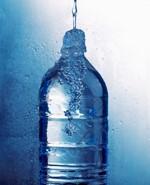Skip to main content
If you would like to store water for emergencies, here are some suggestions for safely storing water:
- Store water in clean, sterilized glass or plastic containers that can be sealed. Avoid metal containers, as these may rust. To sterilize the container, boil the container and lid in water, or use bleach by mixing one tablespoon of unscented bleach in one gallon of water, and soak the containers in this solution for five minutes. Drain the containers and allow to air dry.
- Fill the sterilized container with tap water and seal securely. If possible, put parafilm tape around the threads of the bottle to make sure it is tightly sealed. Store in the refrigerator if possible, or in a cool, dark location. Because chlorine in the tap water will slowly go away, replacing the water every six months is recommended. If this is not possible, add about ½ teaspoon of bleach to every five gallons of water. This extra disinfectant will extend the shelf life. Water will taste flat after storage, but replacing the water every six months should help.
- Using bottled water for long-term storage is not always a good idea. Bottled water is a good source of drinking water during emergencies, but it doesn’t necessarily store as well as tap water. Bottled water may not contain a disinfectant such as chlorine, so bacteria could grow in it over time.

